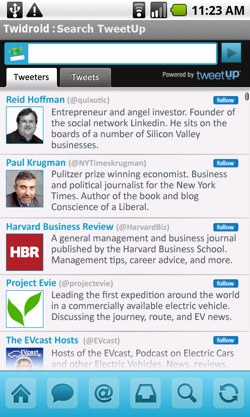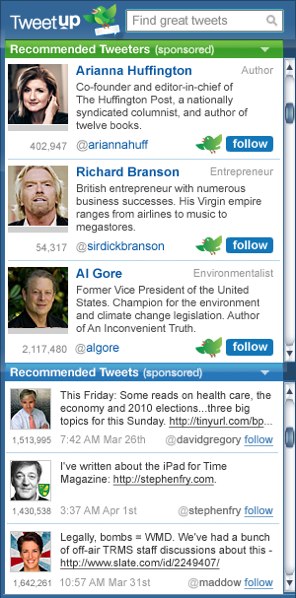 Last night, Twitter finally unveiled the details of its long-awaited ad platform, Promoted Tweets. The news, at least at first glance, couldn’t have come at a worse time for TweetUp, the ‘AdSense for Twitter‘ startup that had launched out of the Idealab incubator a mere 24 hours earlier. So did TweetUp have the worst startup launch timing ever? Earlier this afternoon I spoke with TweetUp (and Idealab) CEO Bill Gross — best known as the founder of Overture and the man who pioneered search advertising — who is confident that the startup is not headed to an early grave.
Last night, Twitter finally unveiled the details of its long-awaited ad platform, Promoted Tweets. The news, at least at first glance, couldn’t have come at a worse time for TweetUp, the ‘AdSense for Twitter‘ startup that had launched out of the Idealab incubator a mere 24 hours earlier. So did TweetUp have the worst startup launch timing ever? Earlier this afternoon I spoke with TweetUp (and Idealab) CEO Bill Gross — best known as the founder of Overture and the man who pioneered search advertising — who is confident that the startup is not headed to an early grave.
For those that missed the news, Twitter’s Promoted Tweets allow advertisers to display tweets they’ve written in a more prominent position than they would normally receive. For starters, Twitter is showing them at the top of results pages for its real-time search engine, but in the future it intends to roll out Promoted Tweets to third-party Twitter clients and users’ Twitter streams. These Promoted Tweets look a lot like regular tweets, and users can engage with them as if they were ‘normal’. TweetUp has some major similarities — it also shows sponsored tweets based on search keywords. But Gross contends that there are some key differences.
The Differences
The biggest difference, Gross says, lies in the search results themselves. For a long time, Twitter’s search engine would only show results in reverse chronological order, with new tweets flowing in the order they were created. This is great for keeping tabs on breaking news, but it also has a relevance problem — the best tweets get lost in the noise. Twitter recently made a major improvement by pinning up to three of the most popular tweets matching a given query to the top of results pages, with the real-time stream filling in below them. That’s a big step, but the focus is still largely on the most recent tweets as opposed to the most interesting ones.
TweetUp, on the other hand, puts less focus on the most recent tweets and instead reorders the entire page of results based on relevance, using metrics like retweet frequency, popularity, and how popular links in each tweet are. The site also has an authority ranking for each user on each topic — if you’ve previously tweeted a lot about the iPad over an extended period of time, you’ll probably have a higher authority than someone who is mentioning it for the first time.
Another difference Gross points out lies in how the sponsored tweets themselves are displayed: on Twitter, they’re at the top of the page (for now). On TweetUp, bidding on a sponsored tweet doesn’t guarantee that it will be the top result on a given page. Bidding does boost your authority on that topic and makes it much more likely that your tweet will appear in results, but if a well established expert in the field is tweeting about the same topic, their tweets might appear above your sponsored tweet. This is meant to help the results feel more organic, so that tweets don’t feel “forced” into your feed. Twitter’s official ad platform uses a metric called resonance to get rid of bad ads, but it doesn’t have an impact on the ad’s position onscreen (it’s either at the top of the page or it isn’t).

The last difference Gross highlighted was the market he was trying to address. He believes Twitter is going after the bigger brands and agencies with large CPM buys for its Promoted Tweets, whereas TweetUp is meant to be more of a self-service model, allowing users to bid on the long-tail of keyword matches. Of course, it’s entirely possible that Twitter will offer its own self-service tools, so this may not be a difference after all.
What Will Actually Matter
Ultimately, I don’t think many of these differences will last for long if they are proven to be advantages for TweetUp. Twitter is almost certainly working to further improve its search results using relevance algorithms. Likewise, if Twitter sees that TweetUp’s self-service model is working well for a long tail of local businesses looking to run their own ads, then I can’t see a reason why it wouldn’t launch one itself.
What will matter is how much distribution TweetUp can get in the next few months. Remember, Twitter is only offering its Promoted Tweets on its own site for now, which means that third-party Twitter clients (which many people use exclusively) are left to their own devices to integrate ads themselves. And TweetUp is making a very tempting proposition: it’s giving developers who integrate the service 50% of the ad revenue. Likewise, publishers can integrate a TweetUp widget that uses AdSense-like technology to display sponsored tweets relevant to the content on their site. TweetUp is also paying some developers up front to integrate the service. Its roster of partners already include Seesmic, Twitdroid (a popular Android client), twitterfeed and Answers.com.
And, in a much-needed nugget of good news for TweetUp, Twitter COO Dick Costolo said earlier today that Twitter would not require developers to exclusively offer its Promoted Tweets, so TweetUp and Twitter’s own ads could potentially co-exist in third-party clients.
That said, once this window of opportunity ends and Twitter does open Promoted Tweets to third parties, there won’t be much reason for a Twitter client to include both TweetUp and the official Twitter search unless TweetUp brings something extra to the table. Which means TweetUp will need to keep its own search engine significantly ahead of Twitter’s, and/or continue to tempt developers with revenue sharing agreements that are better than what Twitter offers.
I still think the odds are stacked against TweetUp. But Gross is an industry veteran — he’s responsible for the search advertising model that turned Google into a giant (his own company, Overture, went public and was acquired by Yahoo for $1.6 billion). So while it’s never surprising when a startup executive claims that their company will survive apparently insurmountable odds, Gross may have what it takes to pull this off.